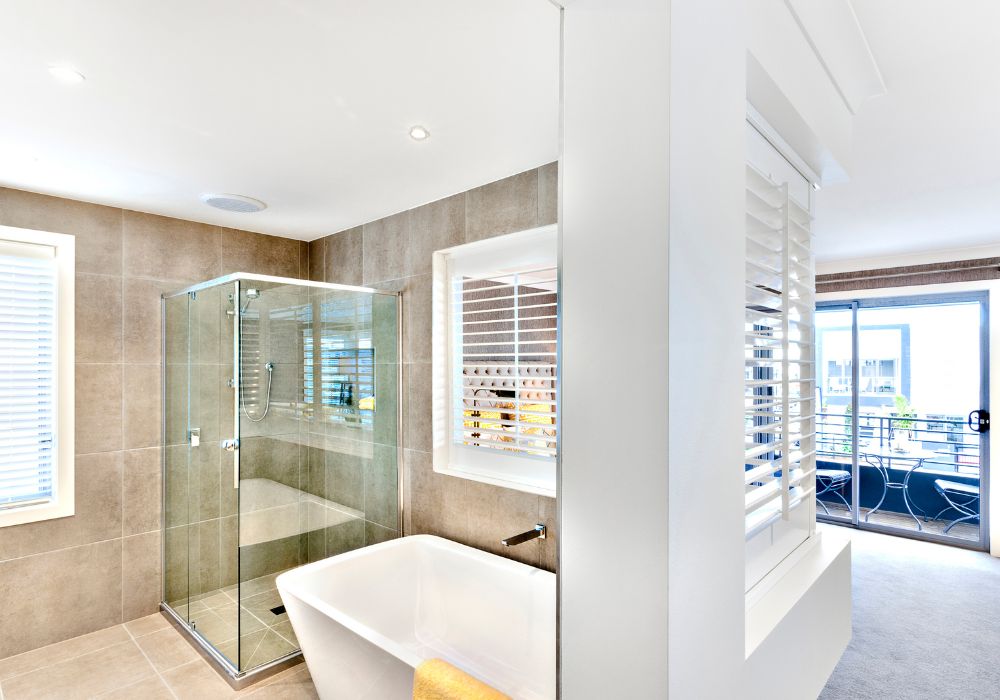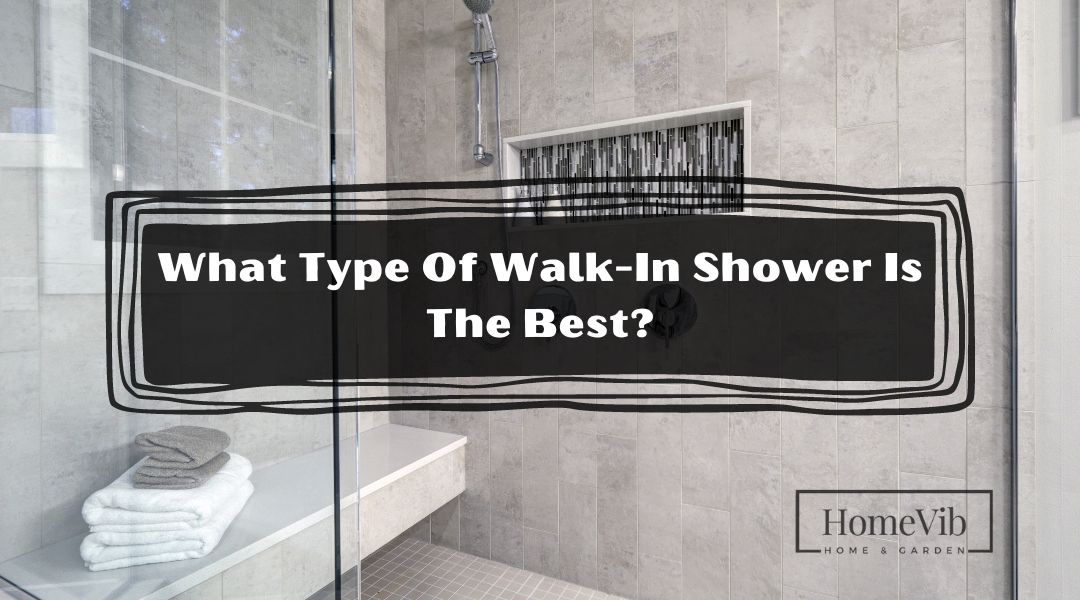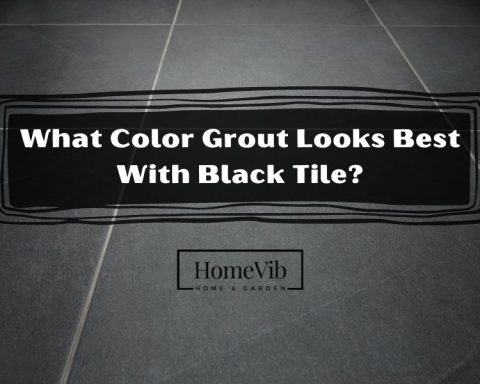Wet Room or Doorless Walk-in Showers have become popular recently, particularly for individuals with mobility issues. As the name suggests, these showers have no curb or door, allowing individuals to walk into the shower area.
They feature a sloping floor that directs water toward a central drain. This design eliminates any raised curbs or thresholds, allowing for a seamless and level entry into the shower space.
Walk-In Shower Types And Ideas:
Each walk-in shower offers unique features and benefits, allowing you to find the perfect fit for your bathroom.
To help you make an informed decision, here are different types of walk-in showers and their detailed insights:
Single Pane Walk-In Showers
Single-pane walk-in showers are widespread for those seeking a minimalist and sleek design.
These showers feature a single pane of glass as the enclosure, creating a seamless and open look in your bathroom. The absence of frames or more panels allows for unobstructed views and spaciousness.
The simplicity of the design makes it versatile and suitable for various styles and bathroom sizes.
Whether you have a small space or a large main bathroom, a single-pane walk-in shower can be customized to fit your needs.
Single Pane Of Glass – No Frame Showers

If you desire a frameless and seamless look for your walk-in shower, consider opting for a single pane of glass with no frame.
These showers offer an ultra-modern and luxurious feel, creating a sophisticated and high-end atmosphere in your bathroom.
The uninterrupted expanse of glass panels allows natural light to flow through, brightening the space and making it feel more open and airy.
Fixed Panel Walk-In Showers
Fixed panel walk-in showers offer a combination of functionality and aesthetics. These showers feature a stationary glass panel that serves as a partial enclosure, allowing for easy access while providing some privacy and splash protection.
The fixed panel can be positioned to maximize space use and make a focal point in your bathroom.
Corner Walk-In Showers

Corner walk-in showers are an excellent choice for optimizing space in smaller bathrooms or adding a touch of functionality to larger ones.
These showers are designed to fit into the corner of your bathroom, using the available space.
Imagine a compact bathroom with a corner walk-in shower featuring sleek glass panels and chrome hardware.
The design maximizes the available space, providing a designated shower area without compromising the bathroom layout.
Wet Room Or Doorless Showers
If you’re seeking a bold and contemporary approach to shower design, a wet room or doorless shower might be the perfect choice. Wet rooms or doorless showers offer a seamless and open concept, blurring the boundaries between the shower area and the rest of the bathroom.
These showers are characterized by their lack of enclosures or doors, allowing for a completely open and accessible shower space.
Wet rooms provide a modern and luxurious spa-like experience. They often feature a sloping floor that directs water towards a central drain, eliminating the need for a separate shower tray.
The absence of barriers creates a seamless transition between the shower area and the rest of the bathroom, giving the illusion of a larger and more spacious environment.
The entire bathroom floor becomes the showering area in a wet room or doorless shower. This design allows for a versatile and flexible layout, allowing you to incorporate various shower fixtures and elements.
You can have a rainfall shower head mounted on the ceiling, many body jets for a soothing massage, or even a built-in bench for added comfort and relaxation.
What Type Of Walk-In Shower Is The Best?
With numerous options available, it’s essential to explore the different types of walk-in showers to find the one that best suits your needs and preferences. One type of walk-in shower stands out as the epitome of style and accessibility: the wet room or doorless walk-in shower.
The wet room or doorless design has gained significant popularity in recent years regarding walk-in showers. Offering a modern and luxurious bathing experience, wet rooms have become a preferred choice for many homeowners.
One of the primary advantages of a wet room is its accessibility. The absence of doors or barriers eliminates the need to step over a curb or threshold, making it ideal for individuals with mobility challenges or using mobility aids. The seamless entry point allows easy access, promoting independence and safety within the bathroom.
Wet rooms offer unparalleled customization options, allowing homeowners to create a personalized bathing space that suits their preferences and style. Wet rooms offer limitless design possibilities, from the choice of tiles and flooring to the placement of fixtures and showerheads.
Furthermore, the sloped floor in a wet room directs water towards a central drain, preventing water pooling and reducing the risk of slipping. Proper waterproofing measures are implemented during installation to ensure the integrity of the surrounding structure and prevent water damage.
What’s The Difference Between a Shower And a Walk-In Shower?
Showers and walk-in showers are popular bathing fixtures with distinct features and benefits. While showers are the traditional choice in most bathrooms, walk-in showers have gained popularity for their sleek and accessible design.
Showers are the conventional bathing fixtures that most people are familiar with. They consist of an enclosed area with walls, providing a designated space for bathing.
Showers come in various configurations, including a bathtub with a showerhead or a standalone shower stall with doors or curtains.
One of the defining features of showers is the presence of a curb or threshold that separates the bathing area from the rest of the bathroom.
One of the significant advantages of showers is their versatility. They can be installed in bathrooms of different sizes and layouts, making them suitable for various spaces. Batteries are also affordable and easy to maintain, making them a practical choice for many homeowners.
Moreover, showers with bathtub combinations offer the flexibility to enjoy a quick shower or a relaxing soak in the tub, providing the best of both worlds.
On the other hand, walk-in showers have gained popularity in recent years due to their modern and accessible design. Unlike traditional batteries, walk-in showers eliminate the need for a curb or threshold.
Bypass Shower Door in Satin Black
They feature a seamless entry point that allows you to walk into the shower area, providing a barrier-free bathing experience.
One of the primary benefits of walk-in showers is their enhanced accessibility. The absence of a curb or threshold makes it easier for individuals with mobility challenges, older people, or those using wheelchairs or walkers to enter and exit the shower. This feature improves safety and independence in the bathroom.
This open design also allows more natural light to enter, creating a brighter and more refreshing atmosphere. Investing in a curbless walk-in shower is a smart choice for the long term.
As the population ages and the demand for accessible living spaces increases, having an accessible bathroom becomes a valuable asset.
What Are the Advantages And Disadvantages Of a Walk-In Shower?

Walk-in showers have become popular in modern bathroom designs due to their accessibility, aesthetic appeal, and functionality. However, like any feature, walk-in showers have both advantages and disadvantages.
Advantages of a Walk-In Shower
- The absence of a curb or threshold eliminates the need to step over, making it easier for individuals with mobility issues, the elderly, or those with disabilities to enter and exit the shower.
- The lack of doors or curtains creates an airy and appealing aesthetic. This design also allows for easy movement within the shower. It provides a seamless flow between the shower area and the rest of the bathroom.
- You can choose from various shower head options, such as rain showers, handheld sprayers, or multiple shower heads, for a luxurious bathing experience.
- Walk-in showers are generally easier to clean and maintain compared to traditional batteries.
- Whether you have a small or large bathroom, walk-in showers can be customized to optimize the available area and create a functional and appealing bathing space.
Disadvantages of a Walk-In Shower
- Walk-in showers may splash water outside the designated shower area due to the absence of doors or curtains.
- The open design of walk-in showers may lead to drafts, especially in bathrooms with poor insulation.
- Installing a walk-in shower may require additional construction or remodeling, depending on the bathroom layout.
- Unlike traditional showers with doors or curtains, walk-in showers offer less privacy due to their open design.
- Proper waterproofing and drainage are crucial for walk-in showers to prevent water leakage and ensure the longevity of the shower.
Is It Cheaper To Build a Shower Or Buy One?
The cost of building a shower versus buying one can vary depending on several factors. Building a shower from scratch can be more expensive, requiring materials, labor, and hiring a contractor.
But, buying a prefabricated shower unit can be cheaper and quicker to install. However, the cost of the shower unit itself and any additional installation fees may still make it a significant expense.
The choice between building or buying a shower depends on individual circumstances, such as budget, time constraints, and design preferences.
What Does It Cost To Build a Walk-In Shower?
On average, building a walk-in shower can range between $7,000 and $16,000. Here is a breakdown of the potential expenses involved in building a walk-in shower:
- Materials: The cost of materials will depend on the type of tiles, flooring, showerhead, fixtures, and other accessories chosen for the walk-in shower. Prices can vary based on quality and style.
- Labor: Hiring a professional contractor or plumber for the installation is recommended to ensure proper waterproofing and plumbing. Labor costs depend on the project’s complexity, location, and contractor rates.
- Additional Features: Including other features such as glass doors, seating, multiple shower heads, or niche shelving can increase the overall cost. These features may require custom work or specialized installation, adding to the expenses.
- Permits and Inspections: Depending on local regulations, permits and inspections may be required to construct a walk-in shower. These costs can vary based on location and specific requirements.
Does a Walk-In Shower Need a Door?
No, a walk-in shower does not need a door. One of the defining features of a walk-in shower is its open and barrier-free design. Unlike traditional showers with doors or curtains to enclose the bathing area, a walk-in shower has a seamless entry point without any barriers or obstructions.
The absence of a door in a walk-in shower creates a sense of openness and allows for easy accessibility. It also contributes to an appealing and modern aesthetic in the bathroom.
Yet, it’s important to note that some walk-in showers may still incorporate partial or frosted glass panels to provide privacy while maintaining the open design.











